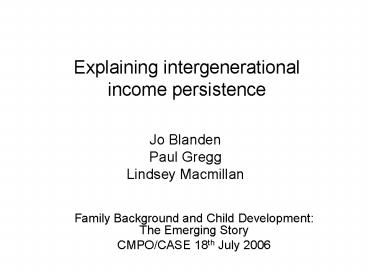Explaining intergenerational income persistence - PowerPoint PPT Presentation
Title:
Explaining intergenerational income persistence
Description:
Main impact of cog and non-cog is through education. ... is also more important for the same reason (some of this is explained by non-cog) ... – PowerPoint PPT presentation
Number of Views:54
Avg rating:3.0/5.0
Title: Explaining intergenerational income persistence
1
Explaining intergenerational income persistence
- Jo Blanden
- Paul Gregg
- Lindsey Macmillan
Family Background and Child Development The
Emerging Story CMPO/CASE 18th July 2006
2
Intergenerational Mobility in socio-economic
circumstances
- Literature has mostly been concerned with
measurement, i.e. the strength of the correlation
between income across generations. - More recently comparisons across countries and
across time have begun to emerge - 2 interesting findings
- UK relatively immobile
- Mobility in UK has declined between 1958 and 1970
birth cohorts - But why?
3
Possible explanations
- Those characteristics influenced by parental
income that lead to higher earnings in later
life. - Several avenues are suggested by the literature.
- Physical Health (birth weight, obesity, childhood
height etc.) - Cognitive skills
- Behavioural and Non-cognitive skills
- Education
- Labour market experience
4
Plan of the Paper
- Consider the routes through which income persists
for the 1970 (BCS) cohort. The objective is to
understand the level of persistence. - Analysis is restricted to sons at this stage.
- Make comparisons between the 1958 (NCDS) and 1970
cohorts in an attempt to understand why
intergenerational transmissions have
strengthened.
5
Modelling approach (1)
6
Modelling approach (2)
- Measure relationship between all mediating
factors and family income. - Measure returns to these characteristics in an
earnings equations. - Estimating sequential earnings equations enables
the relationships between the mediating factors
to be made clear.
7
Data British Cohort Study (1)
- Parental income data available at ages 10 and 16,
average these. - Sons earnings at age 33.
- Cognitive tests at age 5 and 10.
- Mother reports on behaviour age 5.
- Teacher reports on behaviour and self-reported
measures at age 10. - Detailed education information including exam
results. - Work history records from age 30 enable the
construction of number of months unemployed and
out of labour force.
8
Data British Cohort Study (2)
- Cognitive tests
- Age 5 copying and english picture vocab test
- Age 10 reading, maths, British ability scale
- Non-cognitive measures
- Mum, age 5 neurotic, anti-social
- Teacher, age 10 application, clumsiness,
extroversion, hyper-activity, anxious. - Child, age 10 locus of control, self-confidence.
- Child, age 16 malaise.
- All cognitive and non-cognitive measures are
normalised to mean 0, standard deviation 1.
9
Family income relationships
10
Earnings Equations
11
Understanding persistence in the 1970 cohort (1)
- Estimated beta is .320.
- All the mediating factors have a strong
relationship with family income. - A number of non-cognitive traits are strongly
related to earnings. - Cognitive tests also affect earnings, cognitive
and non-cognitive skills predict earnings in a
similar way. - Main impact of cog and non-cog is through
education. - Education extremely important in determining
earnings. - Labour market attachment also important.
12
Understanding persistence in the 1970 cohort (2)
- On their own non-cognitive skills explain 22
percent of intergenerational persistence. Locus
of control and application contribute the lions
share of this. - Adding cognitive tests explains 30 percent.
- Education important, especially achievement at
age 16. Cog and non-cog measures work through
helping kids get better education. - Intermittent early labour market attachment of
poorer kids contributes about 10 percent. - All factors taken together can account for more
than half of total persistence.
13
Decompositions
14
Decompositions
15
Data Cross cohort comparison
- Income is only available at age 16 in NCDS.
Earnings are from age 33. - Cognitive tests for reading, maths and general
ability at 11, similar to BCS. - Non-cognitive tests are different between the
cohorts, use Bristol social adjustment scales for
NCDS. - unforthcoming, withdrawn, depressed, anxious for
acceptance adults, hostile to adults, writing
off adults, anxious for acceptance kids,
hostility to kids, restless, inconsequential
behaviour, misc. - For both cohorts mother reports generate two
measures from rutter scales at age 10,
internalising and externalising. - Concerns about attrition and non-response in both
cohorts, no evidence that this is responsible for
cross-cohort differences.
16
The change in intergenerational mobility
17
Comparative family income relationships (1)
18
Comparative family income relationships (2)
19
Comparative analysis
- Stronger relationships in the second cohort
between family income and non-cognitive skills,
education and unemployment. - Not much change for cognitive ability.
- Suggests possible explanations for the rise in
persistence. - How traits impact on intergenerational mobility
depends also on their changing returns in the
labour market. Results mixed on this. - To see how changes affect intergenerational
mobility need to look at decompositions.
20
Comparative decompositions (1)
21
Comparative decompositions (2)
22
Findings from decompositions
- Non-cognitive traits explain more of
intergenerational relationship in the second
cohort, due to their stronger relationship with
family income. - Education is also more important for the same
reason (some of this is explained by non-cog). - The strengthened relationship between early
unemployment and family income also has a role to
play in higher intergenerational persistence. - Can explain .066 of the .086 rise in the
intergenerational coefficient. 3/4 of the
change.
23
Policy implications
- Fall in mobility is explained by growing
relationship between family income and
non-cognitive skills, education and early
unemployment. - Not due to IQ or cognitive skills.
- 3 possible policy routes
- Close gap in non-cognitive skills (especially
personal efficacy and concentration). - Educational performance at age 16 and beyond.
- Help in early career (policies to avoid NEET).































